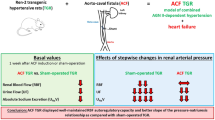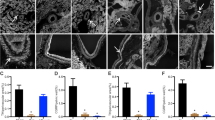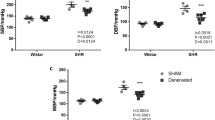Abstract
WE have shown in kidneys from normotensive rats, that dramatic age-related changes take place in the catabolism, but not in the biosynthesis, of prostaglandins (PGs)1. Although PG catabolic enzymes were active in the late prenatal period, they rose to a peak (60-fold relative to the adult) around 19d postnatally, dropping to adult levels by day 40 (ref. 1). We have termed this period of peak activity of PG catabolism the ‘critical prostaglandin period’2. Since the PG catabolising system is principally located in the cortex3,4, and since cortical maturation is almost entirely a postnatal event (during the first 4–5 weeks) supported by an intrarenal blood flow redistribution5, the sharp increase in PG catabolism implied an intrinsic requirement by the developing kidney to eliminate locally-formed or plasma PGs. PG catabolism possibly functioned as a protective measure1 against the potentially harmful effects of the PGs which in this species possess potent vasoconstrictor properties6. We theorised that unless inactivated, these compounds could interfere with the redistribution of blood flow to the cortex and consequently with normal corticogenesis. We were therefore interested in investigating the activity of the PG system in spontaneously hypertensive rats (SHR) at various stages of pre- and early hypertension to compare this activity with age-paired groups of control normotensive rats in an attempt to determine first whether an abnormality in the prostaglandin system exists, second, whether this abnormality appears around the ‘critical prostaglandin period’ and, third, whether this abnormality develops before or after the onset of hypertension.
This is a preview of subscription content, access via your institution
Access options
Subscribe to this journal
Receive 51 print issues and online access
$199.00 per year
only $3.90 per issue
Buy this article
- Purchase on Springer Link
- Instant access to full article PDF
Prices may be subject to local taxes which are calculated during checkout
Similar content being viewed by others
References
Pace-Asciak, C., J. biol. Chem., 250, 2795–2800 (1975).
Pace-Asciak, C. R., and Rangaraj, G., J. biol. Chem., 251, 3381–3385 (1976).
Larsson, C., and Änggård, E., Eur. J. Pharmac., 21, 30–36 (1973).
Pace-Asciak, C., and Domazet, Z., Biochim. biophys. Acta, 380, 338–343 (1975).
Nash, M. A., and Edelman, C. M., Nephron, 11, 71–90 (1973).
Malik, K. U., and McGiff, J. C., Circulation Res., 36, 599–609 (1975).
Axen, U., Green, K., Horlin, D., and Samuelsson, B., Biochem. biophys. Res. Commun., 45, 519–525 (1971).
Pace-Asciak, C. R., Advances in Prosiaglandin and Thromboxane Research, 1 (edit. by Samuelsson B., and Paoletti, R.), 35–46 (Raven, New York, 1976).
Lowry, O. H., Rosebrough, N. J., Farr, A. L., and Randall, R. J., J. biol. Chem., 193, 265–275 (1951).
Armstrong, J. M., et al., Nature, 260, 582–586 (1976).
Pace-Asciak, C. R., Fedn Proc., 35, 88 (1976).
Author information
Authors and Affiliations
Rights and permissions
About this article
Cite this article
PACE-ASCIAK, C. Decreased renal prostaglandin catabolism precedes onset of hypertension in the developing spontaneously hypertensive rat. Nature 263, 510–512 (1976). https://doi.org/10.1038/263510a0
Issue Date:
DOI: https://doi.org/10.1038/263510a0
This article is cited by
-
Arachidonic acid metabolites and haemodynamics of the neonate
Pediatric Nephrology (1993)
-
Content of precursors for prostaglandin biosynthesis in renal lipids during development of spontaneous arterial hypertension
Bulletin of Experimental Biology and Medicine (1984)
-
15-Hydroxyprostaglandin dehydrogenase and hexokinase in spontaneously hypertensive rat kidney
Experientia (1984)
-
Formation and metabolism of prostaglandins in the kidney
Kidney International (1981)
-
Production of prostaglandins in homogenates of kidney medullae and cortices of spontaneously hypertensive rats fed menhaden oil
Lipids (1981)
Comments
By submitting a comment you agree to abide by our Terms and Community Guidelines. If you find something abusive or that does not comply with our terms or guidelines please flag it as inappropriate.



